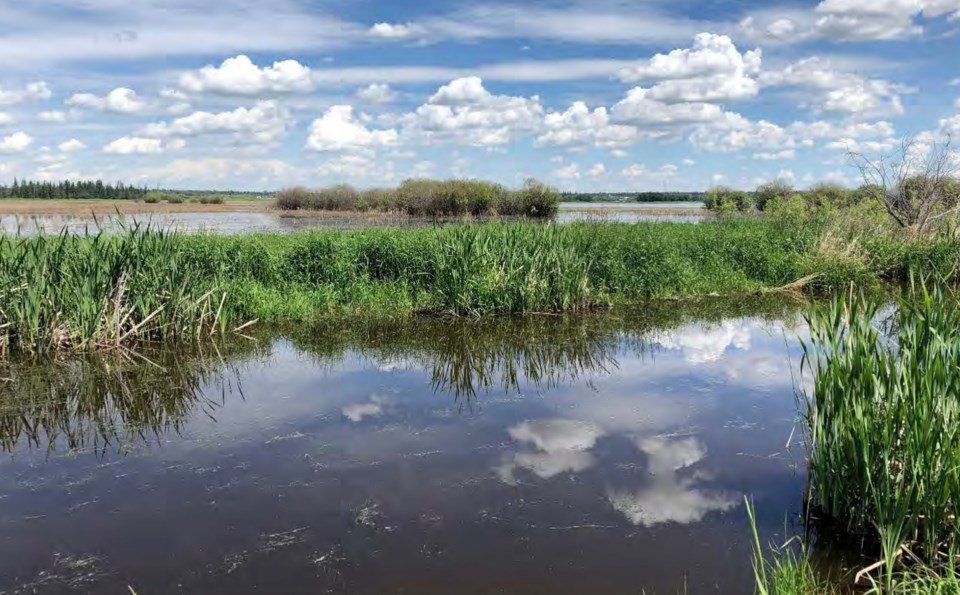A Morinville student hopes her research on stormwater runoff and water quality will spark increased awareness about pollutants carried into local rivers and lakes.
Katie Campbell, in her third year of a conservation biology degree at the University of Alberta, took part in the university's Festival of Undergraduate Research and Creative Activites (FURCA) last week. Campbell presented a study she carried out last summer quantifying how stormwater runoff affected water quality in the Manawan Canal in Morinville.
Stormwater refers to rain and melted snow that travels over urban services like roadways and sidewalks, collecting various substances, before entering a municipality's drainage system and eventually being deposited in a local body of water.
The Manawan Canal is the main receptacle for stormwater runoff for the northern part of Morinville, and the Canal travels south through Sturgeon County before eventually joining the Sturgeon River.
Last summer, Campbell took eight water samples from the Canal both before and after stormwater input. She found stormwater increased the alkalinity, hardness, dissolved oxygen, and pH level of the Canal in varying amounts.
“I wanted to look at how the stormwater input into the creek affected water quality, and if it did, if it was above the normal values of what was to be expected in the area,” Campbell said in an interview.
“I found that all the values were within what was to be expected in this area, but you can see an impact of the stormwater input into the stream on the dissolved oxygen, alkalinity, pH, and total hardness,” she said.
Campbell's research found stormwater input actually increased the dissolved oxygen level in the Canal by 3.6 milligrams per litre, bringing the overall level to 10 milligrams per litre. A 1997 report from the Alberta Environmental Protection ministry (now Environment and Protected Areas) says dissolved oxygen is essential to supporting aquatic life forms.
While increased levels of dissolved oxygen can be a sign of good water quality, the 1997 report says, fish and other river-dwelling wildlife can react differently to sharp changes in dissolved oxygen levels.
Campbell's tests also found that the overall pH level, a measure of overall acidity, went from a 7.5 to a 7.9 after stormwater input in the Canal. The higher the pH level, the more basic or alkaline the water is.
The current water quality guidelines from the province say that an ideal pH level should remain between 6.5 and 9.0 in natural bodies of water like the Sturgeon River.
The most significant indicator change Campbell's test found was a nearly 200 parts per million (ppm) jump in total water hardness, meaning the stormwater input increased the amount of calcium carbonate, or salt, in the water. Campbell's test found water hardness at a level of 387.5 ppm after stormwater input in the Canal.
While the federal government's drinking water guidelines state hardness levels above 500 ppm are “unacceptable for most domestic purposes,” the provincial government's water quality guidelines state other metals and chemicals, such as nickel and sulphate, can have varying reactions to different hardness levels.
“All values are what would be considered normal in this area, but we can see that we are having an impact even if it's quite small,” Campbell said. “I was surprised in a way, but also not, because it is water coming off of the streets (and) people's driveways, so it will probably have some contaminants that will affect water quality.”
“I don't know how possible it would be or if there's any need to change anything in Morinville, but on a bigger scale, just pay more attention to what we are putting into our waterways,” she said.
The Town of Morinville did not respond to the Gazette's interview request.
St. Albert's senior manager of utilities, Regan Lefebvre said the city's main method of preventing adverse effects from stormwater runoff is the use of oil and grit interceptors in high-risk outfalls along the Sturgeon River.
An oil and grit interceptor catches sand and other minerals swept up by stormwater before it flows into the Sturgeon, Lefebvre said.
“If there's any an oil spill or an oil leak, a small one, they will capture that,” he said. “They skim off the top and the heavier solids will settle out, and then we clean those out regularly.”
Lefebvre said the city also has about 6,000 catch basins, the small metal drains that bridge roadways and curbs. The city cleans roughly 1,000 each year on a rotating cycle.
“We'll clean everything out of the bottom of the catch basin and we'll de-water that and we'll haul that to a landfill.”




